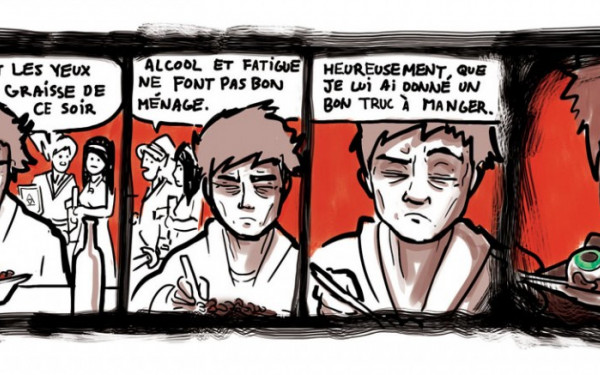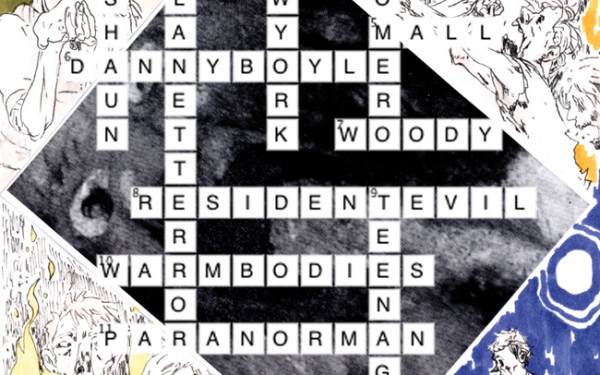Bite of The Living Dead
Sights, Sounds and Sociopolitics at the Zombie Walk
Though brains are their mantra, what being part of a zombie walk really takes is guts.
True, it’s preferable if those guts are dripping out of gaping abdominal wounds or being worn like a grisly feather boa in a glam-goes-gory fashion statement, but it takes guts nonetheless.
If you’re talking real bravery, or at least confidence to let your blood-splattered freak flag fly, that’s another story. Go back a few years, and people were terrified of anybody who would openly cop to being obsessed with the zombies.
In the post-Columbine world, it was definitely not okay to be associated with any scene that was the least bit macabre. Zombies were a subculture in the truest sense—you may have risked social stigma if you were a true believer, you had to go out of your way to be really into it, but once you did, you found obscure gems like Garden of the Dead.
Times have changed. Now, the walking dead are everywhere, including mainstream television, where AMC, the station that brings you Mad Men, also brings you… well, The Walking Dead.
Brad Pitt is slated to star in an adaptation of quirky nonfiction bestseller World War Z. Hell, Wikipedia lists Pirates of the Carribean: On Stranger Tides as a bona fide zombie flick.
Safe to say, it’s never been safer to be a corpse.
Partial to the Perished
I’ve been down with the dead since taking in my first zombie movie, the 2004 remake of George Romero’s seminal Dawn of the Dead.
Sitting in Decarie Square’s Dollar Cinema, a bag of ultra-cheap popcorn in my lap, I waited eagerly for each new dismemberment, hoping that the next bite would lead to an even bigger burst of blood than the last. Since then, it’s been nothing but love for the lifeless, and Hollywood seems to match my love heartbeat for terrified heartbeat.
I’ve sat through countless movies, both great (28 Days Later, Shawn of the Dead), terrible (Land of the Dead, the Resident Evil series) and as is often the case, a cheesy combination of both (Dead Snow, which is either a brilliant analysis of the Norwegian government’s actions during World War II, or an excuse to dress zombies up as Nazis and let them disembowel people).
I’ve played countless rounds of the Nazi Zombie mode in Call of Duty. The Walking Dead is literally the only comic book I’ve read since I hit puberty, and in its TV show form is now one of but a handful that I watch religiously. I’ve read The Zombie Survival Guide, and yes, I do have plan for the inevitable apocalypse, thank you very much.
I’ve even dressed up and lurched through Montreal’s downtown as part of our annual zombie walk. And I’m not alone. By my count, roughly 1,000 ghouls showed up at this year’s edition, in varying stages of decomposition, and similar events have been held around the world, from Stockholm to Edmonton.
Meeting outside of Mont-Royal Metro on a slightly chilly afternoon, the zomb-romp’s atmosphere was less “pure terror” and more “fun for the whole family.” It was a sort of utopia for the non-living; there was a zombie costume for everyone, no matter what your taste or station in life.
Doctor zombies mingled with cop zombies. Army zombies and prisoner zombies shuffled to the same beat. Punks, metal-heads and hockey players with even bigger head wounds than you would normally see took turns checking each other out. French and English-speaking corpses wandered around, chain smoking (I guess once you’re dead, cancer stops being a
concern.)
Similarly, a lot of zombies seemed to be into weed. Getting high must have a certain appeal if you’ve been six feet down. Perhaps most disturbingly, a zombie Santa toting a bag of body parts was hanging out with zombie clowns, perhaps the only kind of zombie that is even more frightening when actually alive.
Horror is something these people take seriously.
“I watch horror movies day and night. I fall asleep to horror movies,” bragged Christine Valente, who was one of the more popular sentient cadavers around. While her costume was suitably disturbing, the real draw was Charlie, her blood-splattered Pomeranian, who waddled among the ghouls with a human hand in his mouth.
While getting a dog to carry around a plastic severed appendage is surprisingly easy (just stuff it with bacon and dog treats, according to Valente), not all zombie-related enterprises come that easily; there are still places the zombie plague hasn’t spread.
“I’m from Newfoundland; we don’t have things like this,” said first-time walker Nancy Kelly. “If I did something like this in Newfoundland, I’d be carted away in a police van. It’s fun to have the freedom to do it.”
“I’m from Newfoundland; we don’t have things like this. If I did something like this in Newfoundland, I’d be carted away in a police van.” —Nancy Kelly, zombie walker
Post-Life Politics
The diversity at the event was amazing, especially since the horror of a zombie
apocalypse is that the enemy is homogenous. Ask any fan, and they’ll tell you: one zombie equals a funny, gory kill. Shit only goes down when there’s a big, hungry crowd of what used to be people, all with brains on the brain.
This is also the fundamental appeal of zombies. Unlike vampires or other monsters, zombies are us. They have the same blood we do, the only difference being that theirs has congealed in their veins.
“I also have always liked the monster-within idea,” George Romero once said. “I like the zombies being us. Zombies are the blue-collar monsters.”
Romero is the king of the corpses. His 1968 film Night of the Living Dead arguably set the template for every zombie movie that followed. While his later efforts grew increasingly tired—especially those made in the new millennium—there is one aspect of his films that was ignored by his hackier successors but adopted by auteurs: a political message.
A film like Resident Evil may have a vague anti-corporate message (the villain is the ridiculously evil Umbrella Corporation, which seems to want to profit by turning all of its customers,i.e. humanity, into mindless horrors. Any similarities to Fox News is purely coincidental).
But Romero’s films have a sublime beauty in the themes hidden among the severed limbs. Night of the Living Dead accidentally became an allegory for racism following the assassination of Martin Luther King, Jr. Dawn of the Dead, which was set in a besieged mall, was about mindless consumerism. Even the awful-except-for-Dennis-Hopper Land of the Dead tried to
portray zombies as a metaphor for the oppressed underclass, struggling under the tyranny of the rich.
If you think I’m stretching on this political thing, keep in mind that there is currently a book out by Tufts University professor Daniel Drezner entitled Theories of International Politics and Zombies.
Despite their fondness for brains, few in the zombie mass shared my fondness for
mixing cultural deconstruction with my carcasses.
“I don’t read that deep into zombie films, honestly,” said Valente. “I think they’re awesome, and I love zombie movies, and I think it’s fun to have a day to dress up like
a zombie.”
Nevertheless, I couldn’t help but feel there was a message in there somewhere. One guy held up a sign claiming, “Bin Laden and Ghaddafi will be with us soon.” Many were dressed in torn up business suits, the glazed look on their faces little different than mine after eight hours staring at a computer screen.
Could it be that this was all a big statement on the military-industrial complex, or the stupefying nature of labour in a capitalist
system? Not so much, according to Gilles Rousseau.
Rousseau is a VP at the Spasm Film Festival. Founded in 2002, the festival has been bringing the bloodiest of the bloody to audiences who need a little screaming at their film screenings.
Though the festival didn’t organize the zombie walk, the event ended at Club Soda, where Spasm showed several locally made short zombie flicks.
“It’s a representation of society,” he said. “So yes, there’s that commentary in a second degree, but it’s primarily I think that most of the people want to live in this moment, and have fun.”
Brains for Thought
It seems stupid to get upset that an event that included a guy dressed as an undead member of pop-group LMFAO shuffle-dancing down the street didn’t have a political message. It’s missing the forest not for the trees, but for the friggin’ leaves—an intensely anal bit of nitpicking.
The fact is, the zombie walk is just awesome from any point of view. It’s quite fun and boasts amazing creativity. Aside from hockey, a zombie walk might be the only thing that people from every single demographic in Montreal can agree on.
“We’re here because it’s fun,” said Vincent Tremblay, giving me a look that implied I might have actually had my brain removed by a zombie when I asked him if his military zombie getup had any underlying message. “I like the military and I like zombies. Combine them together, you get awesomeness.”
Maybe it’s easier to discuss the socio-political message of Diary of the Dead when the guy you’re talking to doesn’t have an eyeball dangling from his socket. Or maybe I’m over-thinking things.
But as I drifted through the sea of dangling body parts and exposed crania, I couldn’t help but think of _The Shawshank Redemption_—though it features all of zero zombies or references thereto—when Tim Robbins’ character, rather dwelling in his thoughts, learns to “get busy living, or get busy dying.”
On a cold day in October, a thousand Montrealers did him one better. They got busy living by getting busy dying.

1__900_598_90.jpg)
2__700_1054_90.jpg)
3__700_1054_90.jpg)
4__700_1054_90.jpg)
5__700_1054_90.jpg)
6__700_1054_90.jpg)
7__700_1054_90.jpg)
8__700_1054_90.jpg)
9__700_1054_90.jpg)
_600_832_s.png)

3_600_375_90_s_c1.jpg)
_600_375_90_s_c1.jpg)

